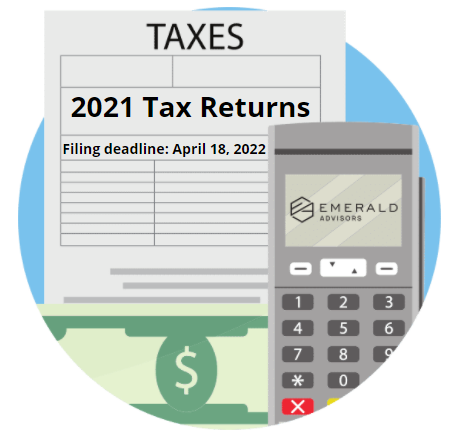2021 Tax Changes Q&A

2021 Tax Changes
It’s never too early to begin gathering what you’ll need to file your 2021 tax year return. As you get started, this guide can be a helpful reference as you go into tax prep season feeling confident on what to expect. Our hope for you this April 18? No surprises!
This post will be up for you to revisit when you have the time and space to sit down and start working through your tax prep list. This list is a summary of the highlights to give you a quick overview.
And remember, we are always here to help so don’t hesitate to reach out if you have questions, no matter how small. We’re here to assist you with all your tax planning needs!
*Note the following several bullets phase-out for high-income earners. However, we have included it as it may be useful information for your kids or other family members.
2021 Tax Guide Highlights
- The Child and Dependent Care Credit is fully refundable for 2021, and the maximum credit percentage has jumped to 50%—good news for working parents.
- If you’ve been receiving advance child tax credit payments since July 2021, be on the lookout for Letter 6419 from the IRS in January 2022. It will detail your payments and how to report them on your return.
- The third stimulus payment sent out in March 2021 won’t be taxable, just like the other two.
- If you didn’t receive stimulus money in 2021 but think you qualify, there is still time with the Recovery Rebate Credit.
General Tax Questions
- When is the deadline for filing taxes this year?
The deadline for filing taxes is Monday, April 18, 2022.
- How do tax brackets work?
Here’s a quick review:
The U.S. income tax system is progressive, which imposes a higher percentage rate on taxpayers with higher incomes.
The tax bracket that the highest dollar of your income falls into is called your marginal tax rate. But because of the progressive system, your tax liability isn’t simply your marginal rate multiplied by your taxable income. The rate you pay is known as your effective tax rate.
Here’s a real-life example that shows how it works:
Let’s say Bill is a single filer and has $50,000 in taxable income.
- From $0 to $9,950, Bill is taxed at 10%.
- From $9,951 to $40,525, he is taxed at 12%.
- From $40,526 to $50,000 Bill is taxed at 22%.
Bill’s marginal tax rate is 22%. In reality, once he runs the calculations, Bill will pay around 13.5% of his income. This is his effective tax rate which is equal to about $6,750.
- What is the standard deduction for 2021?
For 2021, the standard deduction has increased slightly to adjust for inflation.
|
Filing Status |
2020 |
2021 |
|
Single |
$12,400 |
$12,550 |
|
Married Filing Jointly |
$24,800 |
$25,100 |
|
Married Filing Separately |
$12,400 |
$12,550 |
|
Head of Household |
$18,650 |
$18,800 |
- Should I itemize or take the standard deduction?
The standard deduction was raised in 2017 and this limited other deductions including capping state and local taxes to $10,000. Hence a majority (around 80%)[i] of Americans now file with standard deductions. The option you choose depends on the one that will maximize your tax benefits. Taxpayers usually claim the option that lowers their tax bill the most.
The standard deduction allows you to deduct the set amount from your taxes, no questions asked. If you plan to itemize, you’ll need documentation to verify your qualifying expenses from a list approved by the IRS.
- What is a tax credit, and which ones should I take?
A tax credit is the amount of money you’re permitted to subtract, dollar for dollar, from any income taxes you owe. Here are seven of the most common ones:
- Child Tax Credit: The Child Tax Credit[ii] is a refundable credit worth up to $3,000 per qualifying child between ages 6 and 17 and $3,600 per qualifying child under age 6. For more information on the 2021 Advance Child Tax Credit, see the section below titled: Advance Child Tax Credit Questions.
- Earned Income Tax Credit (EITC): For 2021, the credit will allow taxpayers 19 and older to qualify while giving a substantial increase to the credit amount for single taxpayers. The credit ranges from $1,502 to $6,728 depending on tax-filing status, income, and number of children. Find out if you qualify by looking at the 2021 EITC tables.[iii]
- Enhanced Child and Dependent Care Credit: For 2021, the child and dependent care credit is fully refundable, and the maximum credit percentage jumps to 50%. The credit allows up to $8,000 in expenses for one child or disabled person and $16,000 for more than one. The full credit is for families making less than $125,000 a year. After that, the credit will phase out.
- Adoption Tax Credit: Families that grew through adoption might qualify for the Federal Adoption Tax Credit. Adoptive parents must earn $216,660 or less to be eligible for the full credit which provides up to $14,440 per eligible child — defined as any person under the age of 18 that is mentally or physically unable to take care of themselves.
- American Opportunity Credit: The American Opportunity Credit allows parents to claim up to $2,500 per student for tuition, activity fees, books, supplies, and equipment during the first four years of college. Students must be enrolled at least half-time.
- Lifetime Learning Credit: Congress raised the 2021 income limits for the Lifetime Learning Credit, worth as much as $2,000. The phase out now begins at $80,000 for single filers and $160,000 for joint filers for 2021. The credit can be used for tuition and related expenses paid for undergraduate, graduate, and professional degree courses for yourself, your spouse, or dependents.
- Saver’s Credit: This tax credit is worth up to $1,000 ($2,000 if married filing jointly) for mid-and low-income taxpayers who contribute to a retirement account.
- What are the standard mileage rates for 2021?
The 2021 standard mileage rate for business driving fell from 57.5¢ to 56¢ a mile. The mileage rate for medical travel and military moves also declined from 17¢ to 16¢ a mile in 2021.
Pandemic Tax Questions
- Can you remind me how much and when stimulus checks were issued?
Yes! The IRS issued three Economic Impact Payments during the coronavirus pandemic for people who were eligible:
- $1,200 in April 2020
- $600 in December 2020/January 2021
- $1,400 in March 2021
These payments were sent by direct deposit to your bank account or by mail as a check or debit card.
- Will I owe taxes on my March 2021 stimulus payment(s)?
No. Like the other two stimulus payments, the March 2021 payment won’t be taxable.
Here’s what the IRS says: “The payment is not income, and taxpayers will not owe tax on it. The payment will not reduce a taxpayer’s refund or increase the amount they owe when they file their 2021 tax return. A payment also will not affect income for purposes of determining eligibility for federal government assistance or benefit programs.”
- I didn’t receive my third stimulus payment (or the full amount) in March 2021. Do I have any recourse?
Yes. You may qualify for the 2021 Recovery Rebate Credit[iv] so long as your information meets the guidelines set by the government’s COVID-19 relief program. If you’re unsure if you received a March 2021 payment or can’t remember the amount you received, you can access that information here.
If you qualify for the rebate credit, you’ll first need to file your 2021 tax return, and then apply for the credit.
- I had student loans canceled or forgiven in 2021. What do I need to know?
Good news! In the past, if student loans were canceled or forgiven for less than the amount you owe, the amount of canceled debt was considered taxable income.
For 2021, this rule is suspended for most student loan debt incurred for post-secondary education. The change is only temporary, though. In 2026, forgiven student loan debt will once again be taxed.
Advance Child Tax Credit Questions
- What is the Advance Child Tax Credit, and how will it impact my 2021 taxes?
The American Rescue Plan boosted the child tax credit to $3,000 for families with kids 17 and under for 2021, with an extra $600 for children under age 6.
Half the total credit amount was paid in advance monthly payments beginning in July 2021 unless families opted out of advanced payments. Taxpayers will claim the other half when filing their 2021 income tax return.
- What else do I need to know about the child tax credit for 2021?
Because the advance amounts were based on 2019 or 2020 tax returns, you may have received more or less than what you were eligible for this year.
Taxpayers who collected too much might need to repay some—or even all—of the credit. On the other hand, people who received less can claim the remaining amount when they file their 2021 taxes.
- How do I report advance payments on my tax return?
In January 2022, the IRS will send Letter 6419 to taxpayers showing the total amount of advance child tax credit payments they received in 2021. Filers will need to keep this and any other IRS letters they receive about advance payments with their tax records and refer to them when they file.
Retirement Tax Questions
- What are the retirement plan contribution limits for 2021?
Many contribution limits on retirement plans and IRAs remain the same for 2021:
- 401(k), 403(b), and 457 plans: $19,500. (People born before 1972 can once again put in $6,500 more as a catch-up contribution.)
- Simple IRAs: $13,500, plus an extra $3,000 for people age 50 and up.
- Traditional and Roth IRAs: $6,000, plus $1,000 as an additional catch-up contribution for those age 50 and up.
- What about required minimum distributions (RMDs) for 2021?
The CARES Act of 2020 allowed seniors to skip their RMDs without penalty. However, RMDs are back for 2021. Anyone who is at least 72 years old by the end of 2021 must take an RMD.
- Are there any tax breaks for senior adults and retirees?
Yes! Here are a few to look out for:
- Larger standard deduction: The standard deduction for seniors is $1,700 higher than the deduction for those younger than 65 who file as individuals ($14,250 for 2021).
- Property tax breaks: Property tax rules differ by state and local jurisdiction. In some areas, people above a certain age who earn below a particular income level qualify for property or school tax exemptions. Be sure to look at specific rules in your area.
- Credit for the elderly and disabled: To qualify for this credit, you must have an AGI below $17,500 ($25,000 if both spouses are 65 and older) and Social Security and pension income under $5,000 ($7,500 for couples).
- Additional IRA deduction: Employees 50 and older can save an additional $1,000 in an IRA for a total of $7,000 in 2021.
- 401(k) catch-up contributions: Older workers with a 401(k) plan can make catch-up contributions. If you were 50 or older in 2021, the catch-up limit is $6,500 for workplace plans.
- No early withdrawal penalty: Once you turn age 59½, you can withdraw money from your IRA for any reason without the 10% penalty. Finally!
- Qualified charitable distributions: Retirees aged 70½ and older who give up to $100,000 directly from their IRA to a qualified charity won’t owe income tax on the gift.
- HSA contribution limit: Individuals aged 55 or older by the end of the 2021 tax year can contribute up to $4,600 to a health savings account (up $50 from 2020).
- Higher long-term care insurance premium limit: The limits on deducting long-term care insurance premiums are higher for 2021. Taxpayers age 71 or older can write off up to $5,640 per person ($5,430 for 2020).
Miscellaneous Tax Questions
- What are the lifetime estate and gift tax exemptions for 2021?
The lifetime estate and gift tax exemption for 2021 jumped from $11.58 million to $11.7 million ($23.4 million for couples).
The gift tax exclusion remains $15,000 per recipient. This means you can give up to $15,000 to each child, grandchild, or any other person in 2021. So long as you stay below the limit, neither you nor your recipient will be required to file a gift tax return or tap the lifetime estate and gift tax exemption.
- What are the capital gain rates for 2021?
Tax rates on long-term capital gains and dividends did not change for 2021, but the income thresholds to qualify for the various rates did increase. Remember, if you sold stocks, mutual funds, or other capital assets that you held for at least one year, any gain is taxed at a 0%, 15%, or 20% rate.
The 0% rate applies for those with taxable income:
- Up to $40,400 for individual taxpayers
- Up to $54,100 for head of household filers
- Up to $80,800 for married filing jointly returns
The 15% rate applies for those with taxable income:
- $40,401 to $445,850 for individual taxpayers
- $54,101 to $473,750 for head of household filers
- $80,801 to $501,600 for married filing jointly returns
The 20% rate applies for those with taxable income:
- Over $445,850 for individual taxpayers
- Over $473,750 for head of household filers
- Over $501,600 for married filing jointly returns
- Are HSA contributions tax-deductible? What else has changed with HSAs?
Yes! The contributions to an HSA are tax-deductible, and the earnings (if invested) are tax-free, as are withdrawals for eligible medical expenses[v]. You report your contributions on Form 8889 with the total contributions transferred to and reported on your Form 1040.
HSA funds, flexible spending arrangements (FSAs), and health reimbursement arrangements (HRAs) can also be used to buy over-the-counter medicines without a doctor’s prescription.
- Any changes in charitable contributions?
Slightly. When you filed in 2020, the $300 charitable deduction was for each taxable “unit”—meaning you got a $300 deduction whether you filed as a single filer or a married couple filing jointly. This year, however, married people filing jointly can each take a $300 charitable deduction for cash donations, for a total of $600.
Hopefully this information is helpful and answered some of your tax questions. If nothing else, you’re better prepared than most to talk with your tax professional, who can address any follow-up questions you may have.
As always, if we can be of help to you, please reach out. Our team is here for you!
[i] Smery, T. Standard Deduction VS. Itemized Deduction: Which is Best for You? Hellobonsai.com [online] Available at: https://www.hellobonsai.com/blog/standard-deduction-vs-itemized-deduction
[ii] (2021, November 24). What’s New About the Child Tax Credit in 2021? Taxoutreach.org. [online] Available at: https://www.taxoutreach.org/tax-credits/child-tax-credit/whats-new-about-the-child-tax-credit-in-2021/?gclid=Cj0KCQiAuP-OBhDqARIsAD4XHpc_YA9C-BHmGI0nnTh9NJWWkJ-APGO8_5Nl2rPk6TIkz8ex80G4snUaAq0yEALw_wcB
[iii] (2022, January 21) EITC Tables. Irs.gov. [online] Available at: https://www.irs.gov/credits-deductions/individuals/earned-income-tax-credit/earned-income-and-earned-income-tax-credit-eitc-tables#EITC%20Tables
[iv] (2022, February 9). Recover Rebate Credit. Irs.gov. [online] Available at: https://www.irs.gov/newsroom/recovery-rebate-credit
[v] Hartill, R. (2021, November 19). HSA-Eligible Expenses in 2021 and 2022. Fool.com. [online] Available at: https://www.fool.com/retirement/plans/hsa/eligible-expenses/




